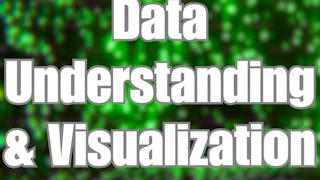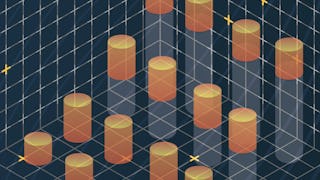This course provides a comprehensive exploration of statistical variability, equipping students with the skills to identify and interpret various measures within data distributions. Learners will delve into calculating variance and standard deviation, comparing these measures, and understanding their implications. The course also emphasizes graphical analysis, enabling students to visually compare distributions with varying degrees of variability.


Measures of Variability
This course is part of Data Exploration in Psychology Specialization

Instructor: Mike Stadler, PhD
Included with
Recommended experience
What you'll learn
Explain the nature and basic measures of variability.
Calculate and interpret variance and standard deviation.
Describe variability in frequency distributions.
Skills you'll gain
Details to know

Add to your LinkedIn profile
10 assignments
See how employees at top companies are mastering in-demand skills

Build your subject-matter expertise
- Learn new concepts from industry experts
- Gain a foundational understanding of a subject or tool
- Develop job-relevant skills with hands-on projects
- Earn a shareable career certificate

There are 7 modules in this course
This module introduces you to your PsycLearn Essentials course. Find out what’s included in this course and how to navigate the modules and lessons. You’ll also learn valuable study tips for successful learning.
What's included
7 readings
Variability matters! Look around you at the variety of people and objects you see right now. Listen to all of the different sounds you are hearing. Variability is what makes statistics (and life) intriguing. What are you interested in? Have you ever wondered why people laugh at different kinds of jokes? Or how to predict peoples’ job satisfaction? Or how people choose who they date? One key to answering any of these questions statistically is variance. Yes, it is important to know the average value of a variable, but perhaps more interesting are how observations differ from the average. In this module, we will examine different ways to calculate and interpret the variability in a variable.
What's included
1 video1 reading
In this module, we explore the definition and nature of variability in detail, and also identify basic ways of describing variability with markers in a data set such as the minimum or maximum value, or various percentiles, along with ranges defined by these markers.
What's included
2 videos4 readings3 assignments
How do we measure the variability of data if it varies each time it is recorded…and why is this important? Let’s say you have been given data from a sleep study that found that its participants slept about 7 hours each night over a month. Each night will not always equal exactly 7 hours; some nights might average less than 7 hours and some nights more than 7 hours. How can we measure this variance over the spread of the data? In this section, you learn how the measures of variability—variance and standard deviation—are calculated and when to use them. Keeping in mind examples like the sleep study will help you to think about other concrete applications of these measures as you work through this section.
What's included
4 videos5 readings3 assignments
Learn how variability can be observed in a distribution by inspecting the shape of the distribution. Just as a single measure of central tendency such as the mean usefully summarizes an aspect of a distribution in a single number while possibly masking other aspects of the distribution, the range or the standard deviation can only communicate so much, and much remains to be seen in a plot of the distribution.
What's included
1 video3 readings3 assignments
What's included
2 readings1 assignment
This module provides a variety of information and tools from the American Psychological Association (APA) that will help inspire you as you complete your coursework and plan your career goals. Explore APA resources on various psychological issues and scholarly research and writing; a list of sites providing valuable resources on diversity, equity, and inclusion in psychology education and in the professional community; resources on a career in psychology; and links to career opportunities at the APA.
What's included
8 readings
Earn a career certificate
Add this credential to your LinkedIn profile, resume, or CV. Share it on social media and in your performance review.
Instructor

Offered by
Explore more from Data Analysis
 Status: Free Trial
Status: Free TrialAmerican Psychological Association
 Status: Free Trial
Status: Free TrialUniversity of Colorado Boulder
 Status: Free Trial
Status: Free TrialArizona State University
 Status: Free Trial
Status: Free TrialUniversity at Buffalo
Why people choose Coursera for their career





Open new doors with Coursera Plus
Unlimited access to 10,000+ world-class courses, hands-on projects, and job-ready certificate programs - all included in your subscription
Advance your career with an online degree
Earn a degree from world-class universities - 100% online
Join over 3,400 global companies that choose Coursera for Business
Upskill your employees to excel in the digital economy
Frequently asked questions
To access the course materials, assignments and to earn a Certificate, you will need to purchase the Certificate experience when you enroll in a course. You can try a Free Trial instead, or apply for Financial Aid. The course may offer 'Full Course, No Certificate' instead. This option lets you see all course materials, submit required assessments, and get a final grade. This also means that you will not be able to purchase a Certificate experience.
When you enroll in the course, you get access to all of the courses in the Specialization, and you earn a certificate when you complete the work. Your electronic Certificate will be added to your Accomplishments page - from there, you can print your Certificate or add it to your LinkedIn profile.
Yes. In select learning programs, you can apply for financial aid or a scholarship if you can’t afford the enrollment fee. If fin aid or scholarship is available for your learning program selection, you’ll find a link to apply on the description page.
More questions
Financial aid available,

